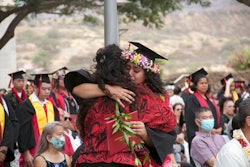Despite the pervasive nature of the “model minority” myth, members of certain Asian ethnicities in California have disproportionate rates of never finishing high school, especially if they’re poor or speak limited English, University of California researchers say.
In a report that arguably underscores national findings that are too-rarely part of the public discourse, UC researchers ascertained that some southeast Asians and other subgroups struggle to even reach college in the first place. Indeed, the 2008 American Community Survey already showed that 40 percent of Cambodians and Hmong as well as 32 percent Laotians in this country lack high school diplomas. Nationally, 19 percent of Cambodians and 23 percent of Hmong lived below the poverty line.
In California, which has the country’s largest and most diverse Asian population, 45 percent of Hmong haven’t graduated high school, the highest proportion among all 40-plus subgroups, UC researchers say. Furthermore, 40 percent of Cambodians and Laotians haven’t finished high school, which is twice the statewide rate regardless of race. And about 20 percent of Pacific Islanders drop out of high school statewide.
Titled “The State of Asian American, Native Hawaiian and Pacific Islander Education in California,” the UC study examines degree attainment and other characteristics of Asian students at California’s K-12 system and public postsecondary institutions, despite large amounts of school data being categorized only as “Asian” or some other lump-sum unit. The report was compiled by the education working group of the UC Asian American and Pacific Islander Policy Multicampus Research Program in collaboration with the office of California state assembly member Mike Eng.
The report’s major findings were released Thursday at a Los Angeles press event that was also attended by Mónica García, board president for the L.A. Unified School District, and Sefa Aina, a member of the White House Commission on Asian Americans and Pacific Islanders who is also director of Pomona College’s Asian American Resource Center.
Among the study’s other major findings:
* More than 40 percent of Vietnamese, Koreans, Laotians, Hmong and Cambodians reported limited English proficiency, double the statewide rate. The same was true of more than 40 percent of Taiwanese and Chinese statewide, who are even more likely to be automatically labeled as model minorities than some of the other ethnicities.
* About 25 percent of Cambodians and Hmong live in poverty, about twice the rate statewide, while 20 percent of Tongans are considered impoverished.
* College financial aid is vital but doesn’t guarantee student retention, much less graduation. Among California’s community college, for instance, Pacific Islanders receive more in scholarship dollars than other subgroups, but their dropout rates also tend to be higher. At UC, Asians actually make up the largest racial group whose parents annually earn less than $45,000, but smaller proportions of Asians receive scholarships than do other races.
* While conventional wisdom holds that professional educators who share students’ cultural and linguistic backgrounds can better offer them culturally responsive classroom instruction, the proportion of Asian educators is noticeably less than that of students in California public schools and universities. In the K-12 system, Asians make up only 7 percent of educators but 12 percent of enrollment, for instance. Disparities were also found in higher education institutions.
The study recommended that public institutions disaggregate data by Asian subgroup, saying it is “urgently needed”; analyze data to determine the obstacles to retention and graduations of Asians; and add and improve pipeline programs to college targeting Asians.
Dr. Lois Takahashi, director of the UC AAPI Policy MRP, says of the 68-page report: “Hopefully, it engages elected officials, communities and organizations to work toward better educational institutions, programs and outcomes for our AANHPI youth.”
In the report, Eng notes that, “as policymakers, it is imperative that our knowledge and understanding evolve continually with respect to whom exactly our populations and subpopulations are and how they are faring academically.”





















